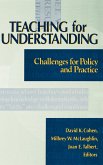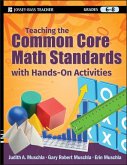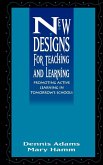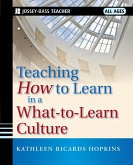- Broschiertes Buch
- Merkliste
- Auf die Merkliste
- Bewerten Bewerten
- Teilen
- Produkt teilen
- Produkterinnerung
- Produkterinnerung
"Teaching for Understanding with Technology shows how teachers can maximize the potential of new technologies to advance student learning and achievement. It uses the popular Teaching for Understanding framework that guides learners to think, analyze, solve problems, and make meaning of what they've learned. The book offers advice on tapping into a rich array of new technologies such as web information, online curricular information, and professional networks to research teaching topics, set learning goals, create innovative lesson plans, assess student understanding, and develop communities of learners. …mehr
Andere Kunden interessierten sich auch für
![Teaching for Understanding Teaching for Understanding]() David K CohenTeaching for Understanding64,99 €
David K CohenTeaching for Understanding64,99 €![Teaching with Fire Teaching with Fire]() Teaching with Fire17,99 €
Teaching with Fire17,99 €![Teaching the Common Core Math Standards with Hands-On Activities, Grades 6-8 Teaching the Common Core Math Standards with Hands-On Activities, Grades 6-8]() Judith A MuschlaTeaching the Common Core Math Standards with Hands-On Activities, Grades 6-829,99 €
Judith A MuschlaTeaching the Common Core Math Standards with Hands-On Activities, Grades 6-829,99 €![Developing Teaching Style in Adult Education Developing Teaching Style in Adult Education]() Joe E HeimlichDeveloping Teaching Style in Adult Education54,99 €
Joe E HeimlichDeveloping Teaching Style in Adult Education54,99 €![New Designs Teaching Learning New Designs Teaching Learning]() Dennis AdamsNew Designs Teaching Learning60,99 €
Dennis AdamsNew Designs Teaching Learning60,99 €![Teaching How to Learn in a What-to-Learn Culture Teaching How to Learn in a What-to-Learn Culture]() Kathleen R HopkinsTeaching How to Learn in a What-to-Learn Culture26,99 €
Kathleen R HopkinsTeaching How to Learn in a What-to-Learn Culture26,99 €![JB Reader on Teaching JB Reader on Teaching]() Jossey-Bass PublishersJB Reader on Teaching47,99 €
Jossey-Bass PublishersJB Reader on Teaching47,99 €-
-
-
"Teaching for Understanding with Technology shows how teachers can maximize the potential of new technologies to advance student learning and achievement. It uses the popular Teaching for Understanding framework that guides learners to think, analyze, solve problems, and make meaning of what they've learned. The book offers advice on tapping into a rich array of new technologies such as web information, online curricular information, and professional networks to research teaching topics, set learning goals, create innovative lesson plans, assess student understanding, and develop communities of learners.
Hinweis: Dieser Artikel kann nur an eine deutsche Lieferadresse ausgeliefert werden.
Hinweis: Dieser Artikel kann nur an eine deutsche Lieferadresse ausgeliefert werden.
Produktdetails
- Produktdetails
- Verlag: Wiley
- Seitenzahl: 152
- Erscheinungstermin: 1. Dezember 2004
- Englisch
- Abmessung: 280mm x 216mm x 10mm
- Gewicht: 474g
- ISBN-13: 9780787972301
- ISBN-10: 0787972304
- Artikelnr.: 21687489
- Herstellerkennzeichnung
- Libri GmbH
- Europaallee 1
- 36244 Bad Hersfeld
- 06621 890
- Verlag: Wiley
- Seitenzahl: 152
- Erscheinungstermin: 1. Dezember 2004
- Englisch
- Abmessung: 280mm x 216mm x 10mm
- Gewicht: 474g
- ISBN-13: 9780787972301
- ISBN-10: 0787972304
- Artikelnr.: 21687489
- Herstellerkennzeichnung
- Libri GmbH
- Europaallee 1
- 36244 Bad Hersfeld
- 06621 890
Martha Stone Wiske is lecturer at the Harvard Graduate School of Education where she co-directed the Educational Technology Center. Her research is concerned with the integration of new technologies and the incorporation of learner-centered teaching for understanding. She is coeditor of Teaching for Understanding: Linking Research with Practice. Kristi Rennebohm Franz is an award-winning Washington State teacher who is known for her innovative use of new technologies in the classroom. Her classroom teaching has been filmed and featured in the PBS documentary Digital Divide. Lisa Breit develops professional development programs to help K-12 teachers design and implement curriculum with new technologies, and consults with school leaders on how to cultivate leadership and provide institutional support as teachers and students gain proficiency.
Preface xiii
Acknowledgements xv
Contributing authors xvii
1 Reproductive competition and its impact on the evolution and ecology of
dung beetles 1
Leigh W. Simmons and T. James Ridsdill-Smith
1.1 Introduction 1
1.2 Competition for mates and the evolution of morphological diversity 2
1.3 Competition for resources and the evolution of breeding strategies 9
1.4 Ecological consequences of intraspecific and interspecific competition
14
1.4.1 Niche expansion 15
1.4.2 Regional distribution and seasonal activity 17
1.4.3 Community dynamics 18
1.5 Conservation 19
1.6 Concluding remarks 20
2 The evolutionary history and diversification of dung beetles 21
T. Keith Philips
2.1 Introduction 21
2.2 Scarabaeinae diversity and tribal classification issues 22
2.2.1 Dichotomiini and Coprini 24
2.2.2 Canthonini 25
2.2.3 Eucraniini 25
2.2.4 Phanaeini 25
2.2.5 Phanaeini + Eucraniini 26
2.2.6 Scarabaeini 26
2.2.7 Gymnopleurini 26
2.2.8 Eurysternini 26
2.2.9 Sisyphini 26
2.2.10 Onitini 27
2.2.11 Oniticellini 27
2.2.12 Onthophagini 27
2.3 Scarabaeine dung beetle phylogenies 27
2.4 The sister clade to the Scarabaeinae 31
2.5 The origin of the dung beetles 33
2.6 The oldest lineages and their geographical origin 34
2.7 Evolution of activity period 36
2.8 Evolution of feeding habits 36
2.9 Evolution of derived alternative lifestyles 37
2.10 Evolution of nidification: dung manipulation strategies 40
2.11 Evolution of nidification: nesting behaviour and subsocial care 42
2.12 Conclusions 44
2.13 Future work/gaps in knowledge 45
3 Male contest competition and the evolution of weapons 47
Robert Knell
3.1 Introduction 47
3.2 Dung beetle horns as weapons 49
3.3 Functional morphology of horns 50
3.4 Horns as predictors of victory 53
3.5 Are beetle horns simply tools? 55
3.6 The evolution of horns: rollers vs. tunnellers 56
3.7 The evolution of horns: population density 59
3.8 The evolution of horns: sex ratio 63
3.9 Future work 64
4 Sexual selection after mating: the evolutionary consequences of sperm
competition and cryptic female choice in onthophagines 66
Leigh W. Simmons
4.1 Introduction 66
4.2 Sperm competition theory 68
4.3 Evolution of ejaculate expenditure in the genus Onthophagus 71
4.4 Evolutionary consequences of variation in ejaculate expenditure 72
4.5 Theoretical models of female choice 75
4.6 Quantitative genetics of ejaculate traits 76
4.7 Empirical evidence for adaptive cryptic female choice in Onthophagus
taurus 78
Box 4.1 Indirect genetic benefits of cryptic female choice in Onthophagus
taurus 81
4.8 Conclusions and future directions 83
4.9 Dedication and acknowledgement 86
5 Olfactory ecology 87
G.D. Tribe and B.V. Burger
5.1 Introduction 87
5.2 Orientation to dung and other resources 87
5.3 Olfactory cues used in mate attraction and mate recognition 91
5.3.1 Morphology of pheromone-producing and -dispersing structures 93
5.3.2 Pheromone-dispersing behaviour 94
5.4 Chemical composition of Kheper pheromones 95
5.4.1 Electroantennographic detection 98
5.4.2 Comparison of the responses of beetle species to attractant compounds
98
5.4.3 The pheromone-disseminating carrier material 102
5.5 Kairomones 103
5.6 Defensive secretions 104
5.7 Conclusions and future directions 105
6 Explaining phenotypic diversity: the conditional strategy and threshold
trait expression 107
Joseph Tomkins and Wade Hazel
6.1 Introduction 107
6.2 The environmental threshold model 109
6.2.1 Does the development of a horn dimorphism in male dung beetles occur
in a manner consistent with the assumptions of the ET model? 110
6.3 Applying the threshold model 118
6.3.1 Predicting the mean switchpoint of a population 118
6.3.2 Estimating the selection on thresholds using the ET model 119
6.3.3 Estimating selection under positive allometry 120
6.4 Future directions 123
7 Evolution and development: Onthophagus beetles and the evolutionary
development genetics of innovation, allometry and plasticity 126
Armin Moczek
7.1 Introduction 126
7.2 Evo-devo and eco-devo - a brief introduction 127
7.3 Onthophagus beetles as an emerging model system in evo-devo and
eco-devo 128
Box 7.1 Developmental genetic tools available in Onthophagus beetles:
utility and limitations 129
7.4 The origin and diversification of novel traits 132
7.4.1 Dung beetle horns as novel traits 133
7.4.2 How horns develop 134
7.4.3 The developmental genetics of horn growth 135
7.4.4 The developmental genetics of pupal remodelling 137
7.4.5 The origin of adult thoracic horns through exaptation 138
7.5 The regulation and evolution of scaling 140
7.5.1 Onthophagine scaling relationships: the roles of nutrition and
hormones 142
7.5.2 Onthophagine scaling relationships: the role of trade-offs during
development and evolution 143
7.5.3 Onthophagine scaling relationships: developmental decoupling versus
common developmental programme 144
7.5.4 Onthophagine scaling relationships: the developmental genetics of
size and shape 147
7.6 The development, evolution, and consequences of phenotypic plasticity
148
7.6.1 Developmental mechanisms and the evolutionary consequences of
plasticity 149
7.7 Conclusion 151
8 The evolution of parental care in the onthophagine dung beetles 152
John Hunt and Clarissa House
8.1 Introduction 152
8.2 Parental care theory 154
8.2.1 A conventional view of parental care theory 154
8.2.2 More recent developments in parental care theory 156
8.3 Testing parental care theory using onthophagine dung beetles 157
8.3.1 Parental care in onthophagine dung beetles 158
8.3.2 The costs and benefits of parental care in onthophagine dung beetles
160
8.3.3 Behavioural dynamics of the sexes during biparental care 163
8.3.4 Confidence of paternity and paternal care 166
8.3.5 Do parents optimize the care they provide? 169
8.3.6 Evolutionary quantitative genetics of parental care 173
8.4 Conclusions and future directions 174
9 The visual ecology of dung beetles 177
Marcus Byrne and Marie Dacke
9.1 Introduction 177
9.2 Insect eye structure 179
9.2.1 The apposition eye 179
9.2.2 The superposition eye 179
9.3 Eye limitations 181
9.4 Dung beetle vision 182
9.4.1 Dim light vision 182
9.4.2 The tapetum and enlarged rhabdoms 185
9.4.3 The canthus 186
9.5 Visual ecology of flight activity 187
9.5.1 Diel flight activity 187
9.5.2 Crepuscular flight activity 188
9.5.3 Endothermy and vision 188
9.5.4 Body size and flight activity 189
9.6 Sexual selection and eyes 190
9.7 Ball-rolling 192
9.7.1 Orientation by ball-rolling beetles 192
9.7.2 The polarization compass 194
9.7.3 Polarization vision 194
9.7.4 Polarization vision in dim light 196
9.8 Conclusions 198
10 The ecological implications of physiological diversity in dung beetles
200
Steven L. Chown and C. Jaco Klok
10.1 Introduction 200
10.2 Thermoregulation 201
10.3 Thermal tolerance 207
10.4 Water balance 208
10.5 Gas exchange and metabolic rate 215
10.6 Conclusion and prospectus 218
11 Dung beetle populations: structure and consequences 220
Tomas Roslin and Heidi Viljanen
11.1 Introduction 220
11.2 Study systems 221
11.2.1 The Finnish cow pat 222
11.2.2 The Malagasy lemur pellet 223
11.3 Range size 224
11.4 Habitat and resource selection 227
11.5 Dung beetle movement 230
11.6 The genetic structure of dung beetle populations 235
11.7 Consequences: spatial population structures and responses to habitat
loss 238
11.8 Perspectives 243
12 Biological control: ecosystem functions provided by dung beetles 245
T. James Ridsdill-Smith and Penny B. Edwards
12.1 Introduction 245
12.2 Functions of dung beetles in ecosystems 246
12.2.1 Dung burial and nutrient cycling 246
12.2.2 Control of dung-breeding flies 247
12.2.3 Control of parasites 250
12.3 Dung beetles in pasture habitats 250
12.4 Seasonal occurrence and abundance of native dung beetles in Australia
251
12.5 Distribution and seasonal occurrence of introduced dung beetles in
Australia 254
12.6 Long-term studies of establishment and abundance 257
12.6.1 Summer rainfall climate area of Queensland 258
12.6.2 Mediterranean climate area of south Western Australia 260
12.6.3 Long-term population trends 261
12.7 Competitive exclusion 262
12.8 Optimizing the benefits of biological control 264
13 Dung beetles as a candidate study taxon in applied biodiversity
conservation research 267
Elizabeth S. Nichols and Toby A. Gardner
13.1 Introduction 267
13.2 Satisfying data needs to inform conservation practice 268
13.3 The role of dung beetles in applied biodiversity research in
human-modified landscapes 270
13.3.1 Dung beetles as a viable candidate for biodiversity research 271
13.3.2 Dung beetles as reliable indicators of environmental change 272
13.3.3 Interpreting disturbance response patterns: application of a
trait-based framework for ecological research 276
13.3.4 Dung beetles as ecological disturbance indicator taxa: applied
examples 286
13.4 Dung beetle conservation 286
13.5 Some ways forward 290
References 293
Subject index 340
Taxonomic index 343
Acknowledgements xv
Contributing authors xvii
1 Reproductive competition and its impact on the evolution and ecology of
dung beetles 1
Leigh W. Simmons and T. James Ridsdill-Smith
1.1 Introduction 1
1.2 Competition for mates and the evolution of morphological diversity 2
1.3 Competition for resources and the evolution of breeding strategies 9
1.4 Ecological consequences of intraspecific and interspecific competition
14
1.4.1 Niche expansion 15
1.4.2 Regional distribution and seasonal activity 17
1.4.3 Community dynamics 18
1.5 Conservation 19
1.6 Concluding remarks 20
2 The evolutionary history and diversification of dung beetles 21
T. Keith Philips
2.1 Introduction 21
2.2 Scarabaeinae diversity and tribal classification issues 22
2.2.1 Dichotomiini and Coprini 24
2.2.2 Canthonini 25
2.2.3 Eucraniini 25
2.2.4 Phanaeini 25
2.2.5 Phanaeini + Eucraniini 26
2.2.6 Scarabaeini 26
2.2.7 Gymnopleurini 26
2.2.8 Eurysternini 26
2.2.9 Sisyphini 26
2.2.10 Onitini 27
2.2.11 Oniticellini 27
2.2.12 Onthophagini 27
2.3 Scarabaeine dung beetle phylogenies 27
2.4 The sister clade to the Scarabaeinae 31
2.5 The origin of the dung beetles 33
2.6 The oldest lineages and their geographical origin 34
2.7 Evolution of activity period 36
2.8 Evolution of feeding habits 36
2.9 Evolution of derived alternative lifestyles 37
2.10 Evolution of nidification: dung manipulation strategies 40
2.11 Evolution of nidification: nesting behaviour and subsocial care 42
2.12 Conclusions 44
2.13 Future work/gaps in knowledge 45
3 Male contest competition and the evolution of weapons 47
Robert Knell
3.1 Introduction 47
3.2 Dung beetle horns as weapons 49
3.3 Functional morphology of horns 50
3.4 Horns as predictors of victory 53
3.5 Are beetle horns simply tools? 55
3.6 The evolution of horns: rollers vs. tunnellers 56
3.7 The evolution of horns: population density 59
3.8 The evolution of horns: sex ratio 63
3.9 Future work 64
4 Sexual selection after mating: the evolutionary consequences of sperm
competition and cryptic female choice in onthophagines 66
Leigh W. Simmons
4.1 Introduction 66
4.2 Sperm competition theory 68
4.3 Evolution of ejaculate expenditure in the genus Onthophagus 71
4.4 Evolutionary consequences of variation in ejaculate expenditure 72
4.5 Theoretical models of female choice 75
4.6 Quantitative genetics of ejaculate traits 76
4.7 Empirical evidence for adaptive cryptic female choice in Onthophagus
taurus 78
Box 4.1 Indirect genetic benefits of cryptic female choice in Onthophagus
taurus 81
4.8 Conclusions and future directions 83
4.9 Dedication and acknowledgement 86
5 Olfactory ecology 87
G.D. Tribe and B.V. Burger
5.1 Introduction 87
5.2 Orientation to dung and other resources 87
5.3 Olfactory cues used in mate attraction and mate recognition 91
5.3.1 Morphology of pheromone-producing and -dispersing structures 93
5.3.2 Pheromone-dispersing behaviour 94
5.4 Chemical composition of Kheper pheromones 95
5.4.1 Electroantennographic detection 98
5.4.2 Comparison of the responses of beetle species to attractant compounds
98
5.4.3 The pheromone-disseminating carrier material 102
5.5 Kairomones 103
5.6 Defensive secretions 104
5.7 Conclusions and future directions 105
6 Explaining phenotypic diversity: the conditional strategy and threshold
trait expression 107
Joseph Tomkins and Wade Hazel
6.1 Introduction 107
6.2 The environmental threshold model 109
6.2.1 Does the development of a horn dimorphism in male dung beetles occur
in a manner consistent with the assumptions of the ET model? 110
6.3 Applying the threshold model 118
6.3.1 Predicting the mean switchpoint of a population 118
6.3.2 Estimating the selection on thresholds using the ET model 119
6.3.3 Estimating selection under positive allometry 120
6.4 Future directions 123
7 Evolution and development: Onthophagus beetles and the evolutionary
development genetics of innovation, allometry and plasticity 126
Armin Moczek
7.1 Introduction 126
7.2 Evo-devo and eco-devo - a brief introduction 127
7.3 Onthophagus beetles as an emerging model system in evo-devo and
eco-devo 128
Box 7.1 Developmental genetic tools available in Onthophagus beetles:
utility and limitations 129
7.4 The origin and diversification of novel traits 132
7.4.1 Dung beetle horns as novel traits 133
7.4.2 How horns develop 134
7.4.3 The developmental genetics of horn growth 135
7.4.4 The developmental genetics of pupal remodelling 137
7.4.5 The origin of adult thoracic horns through exaptation 138
7.5 The regulation and evolution of scaling 140
7.5.1 Onthophagine scaling relationships: the roles of nutrition and
hormones 142
7.5.2 Onthophagine scaling relationships: the role of trade-offs during
development and evolution 143
7.5.3 Onthophagine scaling relationships: developmental decoupling versus
common developmental programme 144
7.5.4 Onthophagine scaling relationships: the developmental genetics of
size and shape 147
7.6 The development, evolution, and consequences of phenotypic plasticity
148
7.6.1 Developmental mechanisms and the evolutionary consequences of
plasticity 149
7.7 Conclusion 151
8 The evolution of parental care in the onthophagine dung beetles 152
John Hunt and Clarissa House
8.1 Introduction 152
8.2 Parental care theory 154
8.2.1 A conventional view of parental care theory 154
8.2.2 More recent developments in parental care theory 156
8.3 Testing parental care theory using onthophagine dung beetles 157
8.3.1 Parental care in onthophagine dung beetles 158
8.3.2 The costs and benefits of parental care in onthophagine dung beetles
160
8.3.3 Behavioural dynamics of the sexes during biparental care 163
8.3.4 Confidence of paternity and paternal care 166
8.3.5 Do parents optimize the care they provide? 169
8.3.6 Evolutionary quantitative genetics of parental care 173
8.4 Conclusions and future directions 174
9 The visual ecology of dung beetles 177
Marcus Byrne and Marie Dacke
9.1 Introduction 177
9.2 Insect eye structure 179
9.2.1 The apposition eye 179
9.2.2 The superposition eye 179
9.3 Eye limitations 181
9.4 Dung beetle vision 182
9.4.1 Dim light vision 182
9.4.2 The tapetum and enlarged rhabdoms 185
9.4.3 The canthus 186
9.5 Visual ecology of flight activity 187
9.5.1 Diel flight activity 187
9.5.2 Crepuscular flight activity 188
9.5.3 Endothermy and vision 188
9.5.4 Body size and flight activity 189
9.6 Sexual selection and eyes 190
9.7 Ball-rolling 192
9.7.1 Orientation by ball-rolling beetles 192
9.7.2 The polarization compass 194
9.7.3 Polarization vision 194
9.7.4 Polarization vision in dim light 196
9.8 Conclusions 198
10 The ecological implications of physiological diversity in dung beetles
200
Steven L. Chown and C. Jaco Klok
10.1 Introduction 200
10.2 Thermoregulation 201
10.3 Thermal tolerance 207
10.4 Water balance 208
10.5 Gas exchange and metabolic rate 215
10.6 Conclusion and prospectus 218
11 Dung beetle populations: structure and consequences 220
Tomas Roslin and Heidi Viljanen
11.1 Introduction 220
11.2 Study systems 221
11.2.1 The Finnish cow pat 222
11.2.2 The Malagasy lemur pellet 223
11.3 Range size 224
11.4 Habitat and resource selection 227
11.5 Dung beetle movement 230
11.6 The genetic structure of dung beetle populations 235
11.7 Consequences: spatial population structures and responses to habitat
loss 238
11.8 Perspectives 243
12 Biological control: ecosystem functions provided by dung beetles 245
T. James Ridsdill-Smith and Penny B. Edwards
12.1 Introduction 245
12.2 Functions of dung beetles in ecosystems 246
12.2.1 Dung burial and nutrient cycling 246
12.2.2 Control of dung-breeding flies 247
12.2.3 Control of parasites 250
12.3 Dung beetles in pasture habitats 250
12.4 Seasonal occurrence and abundance of native dung beetles in Australia
251
12.5 Distribution and seasonal occurrence of introduced dung beetles in
Australia 254
12.6 Long-term studies of establishment and abundance 257
12.6.1 Summer rainfall climate area of Queensland 258
12.6.2 Mediterranean climate area of south Western Australia 260
12.6.3 Long-term population trends 261
12.7 Competitive exclusion 262
12.8 Optimizing the benefits of biological control 264
13 Dung beetles as a candidate study taxon in applied biodiversity
conservation research 267
Elizabeth S. Nichols and Toby A. Gardner
13.1 Introduction 267
13.2 Satisfying data needs to inform conservation practice 268
13.3 The role of dung beetles in applied biodiversity research in
human-modified landscapes 270
13.3.1 Dung beetles as a viable candidate for biodiversity research 271
13.3.2 Dung beetles as reliable indicators of environmental change 272
13.3.3 Interpreting disturbance response patterns: application of a
trait-based framework for ecological research 276
13.3.4 Dung beetles as ecological disturbance indicator taxa: applied
examples 286
13.4 Dung beetle conservation 286
13.5 Some ways forward 290
References 293
Subject index 340
Taxonomic index 343
Preface xiii
Acknowledgements xv
Contributing authors xvii
1 Reproductive competition and its impact on the evolution and ecology of
dung beetles 1
Leigh W. Simmons and T. James Ridsdill-Smith
1.1 Introduction 1
1.2 Competition for mates and the evolution of morphological diversity 2
1.3 Competition for resources and the evolution of breeding strategies 9
1.4 Ecological consequences of intraspecific and interspecific competition
14
1.4.1 Niche expansion 15
1.4.2 Regional distribution and seasonal activity 17
1.4.3 Community dynamics 18
1.5 Conservation 19
1.6 Concluding remarks 20
2 The evolutionary history and diversification of dung beetles 21
T. Keith Philips
2.1 Introduction 21
2.2 Scarabaeinae diversity and tribal classification issues 22
2.2.1 Dichotomiini and Coprini 24
2.2.2 Canthonini 25
2.2.3 Eucraniini 25
2.2.4 Phanaeini 25
2.2.5 Phanaeini + Eucraniini 26
2.2.6 Scarabaeini 26
2.2.7 Gymnopleurini 26
2.2.8 Eurysternini 26
2.2.9 Sisyphini 26
2.2.10 Onitini 27
2.2.11 Oniticellini 27
2.2.12 Onthophagini 27
2.3 Scarabaeine dung beetle phylogenies 27
2.4 The sister clade to the Scarabaeinae 31
2.5 The origin of the dung beetles 33
2.6 The oldest lineages and their geographical origin 34
2.7 Evolution of activity period 36
2.8 Evolution of feeding habits 36
2.9 Evolution of derived alternative lifestyles 37
2.10 Evolution of nidification: dung manipulation strategies 40
2.11 Evolution of nidification: nesting behaviour and subsocial care 42
2.12 Conclusions 44
2.13 Future work/gaps in knowledge 45
3 Male contest competition and the evolution of weapons 47
Robert Knell
3.1 Introduction 47
3.2 Dung beetle horns as weapons 49
3.3 Functional morphology of horns 50
3.4 Horns as predictors of victory 53
3.5 Are beetle horns simply tools? 55
3.6 The evolution of horns: rollers vs. tunnellers 56
3.7 The evolution of horns: population density 59
3.8 The evolution of horns: sex ratio 63
3.9 Future work 64
4 Sexual selection after mating: the evolutionary consequences of sperm
competition and cryptic female choice in onthophagines 66
Leigh W. Simmons
4.1 Introduction 66
4.2 Sperm competition theory 68
4.3 Evolution of ejaculate expenditure in the genus Onthophagus 71
4.4 Evolutionary consequences of variation in ejaculate expenditure 72
4.5 Theoretical models of female choice 75
4.6 Quantitative genetics of ejaculate traits 76
4.7 Empirical evidence for adaptive cryptic female choice in Onthophagus
taurus 78
Box 4.1 Indirect genetic benefits of cryptic female choice in Onthophagus
taurus 81
4.8 Conclusions and future directions 83
4.9 Dedication and acknowledgement 86
5 Olfactory ecology 87
G.D. Tribe and B.V. Burger
5.1 Introduction 87
5.2 Orientation to dung and other resources 87
5.3 Olfactory cues used in mate attraction and mate recognition 91
5.3.1 Morphology of pheromone-producing and -dispersing structures 93
5.3.2 Pheromone-dispersing behaviour 94
5.4 Chemical composition of Kheper pheromones 95
5.4.1 Electroantennographic detection 98
5.4.2 Comparison of the responses of beetle species to attractant compounds
98
5.4.3 The pheromone-disseminating carrier material 102
5.5 Kairomones 103
5.6 Defensive secretions 104
5.7 Conclusions and future directions 105
6 Explaining phenotypic diversity: the conditional strategy and threshold
trait expression 107
Joseph Tomkins and Wade Hazel
6.1 Introduction 107
6.2 The environmental threshold model 109
6.2.1 Does the development of a horn dimorphism in male dung beetles occur
in a manner consistent with the assumptions of the ET model? 110
6.3 Applying the threshold model 118
6.3.1 Predicting the mean switchpoint of a population 118
6.3.2 Estimating the selection on thresholds using the ET model 119
6.3.3 Estimating selection under positive allometry 120
6.4 Future directions 123
7 Evolution and development: Onthophagus beetles and the evolutionary
development genetics of innovation, allometry and plasticity 126
Armin Moczek
7.1 Introduction 126
7.2 Evo-devo and eco-devo - a brief introduction 127
7.3 Onthophagus beetles as an emerging model system in evo-devo and
eco-devo 128
Box 7.1 Developmental genetic tools available in Onthophagus beetles:
utility and limitations 129
7.4 The origin and diversification of novel traits 132
7.4.1 Dung beetle horns as novel traits 133
7.4.2 How horns develop 134
7.4.3 The developmental genetics of horn growth 135
7.4.4 The developmental genetics of pupal remodelling 137
7.4.5 The origin of adult thoracic horns through exaptation 138
7.5 The regulation and evolution of scaling 140
7.5.1 Onthophagine scaling relationships: the roles of nutrition and
hormones 142
7.5.2 Onthophagine scaling relationships: the role of trade-offs during
development and evolution 143
7.5.3 Onthophagine scaling relationships: developmental decoupling versus
common developmental programme 144
7.5.4 Onthophagine scaling relationships: the developmental genetics of
size and shape 147
7.6 The development, evolution, and consequences of phenotypic plasticity
148
7.6.1 Developmental mechanisms and the evolutionary consequences of
plasticity 149
7.7 Conclusion 151
8 The evolution of parental care in the onthophagine dung beetles 152
John Hunt and Clarissa House
8.1 Introduction 152
8.2 Parental care theory 154
8.2.1 A conventional view of parental care theory 154
8.2.2 More recent developments in parental care theory 156
8.3 Testing parental care theory using onthophagine dung beetles 157
8.3.1 Parental care in onthophagine dung beetles 158
8.3.2 The costs and benefits of parental care in onthophagine dung beetles
160
8.3.3 Behavioural dynamics of the sexes during biparental care 163
8.3.4 Confidence of paternity and paternal care 166
8.3.5 Do parents optimize the care they provide? 169
8.3.6 Evolutionary quantitative genetics of parental care 173
8.4 Conclusions and future directions 174
9 The visual ecology of dung beetles 177
Marcus Byrne and Marie Dacke
9.1 Introduction 177
9.2 Insect eye structure 179
9.2.1 The apposition eye 179
9.2.2 The superposition eye 179
9.3 Eye limitations 181
9.4 Dung beetle vision 182
9.4.1 Dim light vision 182
9.4.2 The tapetum and enlarged rhabdoms 185
9.4.3 The canthus 186
9.5 Visual ecology of flight activity 187
9.5.1 Diel flight activity 187
9.5.2 Crepuscular flight activity 188
9.5.3 Endothermy and vision 188
9.5.4 Body size and flight activity 189
9.6 Sexual selection and eyes 190
9.7 Ball-rolling 192
9.7.1 Orientation by ball-rolling beetles 192
9.7.2 The polarization compass 194
9.7.3 Polarization vision 194
9.7.4 Polarization vision in dim light 196
9.8 Conclusions 198
10 The ecological implications of physiological diversity in dung beetles
200
Steven L. Chown and C. Jaco Klok
10.1 Introduction 200
10.2 Thermoregulation 201
10.3 Thermal tolerance 207
10.4 Water balance 208
10.5 Gas exchange and metabolic rate 215
10.6 Conclusion and prospectus 218
11 Dung beetle populations: structure and consequences 220
Tomas Roslin and Heidi Viljanen
11.1 Introduction 220
11.2 Study systems 221
11.2.1 The Finnish cow pat 222
11.2.2 The Malagasy lemur pellet 223
11.3 Range size 224
11.4 Habitat and resource selection 227
11.5 Dung beetle movement 230
11.6 The genetic structure of dung beetle populations 235
11.7 Consequences: spatial population structures and responses to habitat
loss 238
11.8 Perspectives 243
12 Biological control: ecosystem functions provided by dung beetles 245
T. James Ridsdill-Smith and Penny B. Edwards
12.1 Introduction 245
12.2 Functions of dung beetles in ecosystems 246
12.2.1 Dung burial and nutrient cycling 246
12.2.2 Control of dung-breeding flies 247
12.2.3 Control of parasites 250
12.3 Dung beetles in pasture habitats 250
12.4 Seasonal occurrence and abundance of native dung beetles in Australia
251
12.5 Distribution and seasonal occurrence of introduced dung beetles in
Australia 254
12.6 Long-term studies of establishment and abundance 257
12.6.1 Summer rainfall climate area of Queensland 258
12.6.2 Mediterranean climate area of south Western Australia 260
12.6.3 Long-term population trends 261
12.7 Competitive exclusion 262
12.8 Optimizing the benefits of biological control 264
13 Dung beetles as a candidate study taxon in applied biodiversity
conservation research 267
Elizabeth S. Nichols and Toby A. Gardner
13.1 Introduction 267
13.2 Satisfying data needs to inform conservation practice 268
13.3 The role of dung beetles in applied biodiversity research in
human-modified landscapes 270
13.3.1 Dung beetles as a viable candidate for biodiversity research 271
13.3.2 Dung beetles as reliable indicators of environmental change 272
13.3.3 Interpreting disturbance response patterns: application of a
trait-based framework for ecological research 276
13.3.4 Dung beetles as ecological disturbance indicator taxa: applied
examples 286
13.4 Dung beetle conservation 286
13.5 Some ways forward 290
References 293
Subject index 340
Taxonomic index 343
Acknowledgements xv
Contributing authors xvii
1 Reproductive competition and its impact on the evolution and ecology of
dung beetles 1
Leigh W. Simmons and T. James Ridsdill-Smith
1.1 Introduction 1
1.2 Competition for mates and the evolution of morphological diversity 2
1.3 Competition for resources and the evolution of breeding strategies 9
1.4 Ecological consequences of intraspecific and interspecific competition
14
1.4.1 Niche expansion 15
1.4.2 Regional distribution and seasonal activity 17
1.4.3 Community dynamics 18
1.5 Conservation 19
1.6 Concluding remarks 20
2 The evolutionary history and diversification of dung beetles 21
T. Keith Philips
2.1 Introduction 21
2.2 Scarabaeinae diversity and tribal classification issues 22
2.2.1 Dichotomiini and Coprini 24
2.2.2 Canthonini 25
2.2.3 Eucraniini 25
2.2.4 Phanaeini 25
2.2.5 Phanaeini + Eucraniini 26
2.2.6 Scarabaeini 26
2.2.7 Gymnopleurini 26
2.2.8 Eurysternini 26
2.2.9 Sisyphini 26
2.2.10 Onitini 27
2.2.11 Oniticellini 27
2.2.12 Onthophagini 27
2.3 Scarabaeine dung beetle phylogenies 27
2.4 The sister clade to the Scarabaeinae 31
2.5 The origin of the dung beetles 33
2.6 The oldest lineages and their geographical origin 34
2.7 Evolution of activity period 36
2.8 Evolution of feeding habits 36
2.9 Evolution of derived alternative lifestyles 37
2.10 Evolution of nidification: dung manipulation strategies 40
2.11 Evolution of nidification: nesting behaviour and subsocial care 42
2.12 Conclusions 44
2.13 Future work/gaps in knowledge 45
3 Male contest competition and the evolution of weapons 47
Robert Knell
3.1 Introduction 47
3.2 Dung beetle horns as weapons 49
3.3 Functional morphology of horns 50
3.4 Horns as predictors of victory 53
3.5 Are beetle horns simply tools? 55
3.6 The evolution of horns: rollers vs. tunnellers 56
3.7 The evolution of horns: population density 59
3.8 The evolution of horns: sex ratio 63
3.9 Future work 64
4 Sexual selection after mating: the evolutionary consequences of sperm
competition and cryptic female choice in onthophagines 66
Leigh W. Simmons
4.1 Introduction 66
4.2 Sperm competition theory 68
4.3 Evolution of ejaculate expenditure in the genus Onthophagus 71
4.4 Evolutionary consequences of variation in ejaculate expenditure 72
4.5 Theoretical models of female choice 75
4.6 Quantitative genetics of ejaculate traits 76
4.7 Empirical evidence for adaptive cryptic female choice in Onthophagus
taurus 78
Box 4.1 Indirect genetic benefits of cryptic female choice in Onthophagus
taurus 81
4.8 Conclusions and future directions 83
4.9 Dedication and acknowledgement 86
5 Olfactory ecology 87
G.D. Tribe and B.V. Burger
5.1 Introduction 87
5.2 Orientation to dung and other resources 87
5.3 Olfactory cues used in mate attraction and mate recognition 91
5.3.1 Morphology of pheromone-producing and -dispersing structures 93
5.3.2 Pheromone-dispersing behaviour 94
5.4 Chemical composition of Kheper pheromones 95
5.4.1 Electroantennographic detection 98
5.4.2 Comparison of the responses of beetle species to attractant compounds
98
5.4.3 The pheromone-disseminating carrier material 102
5.5 Kairomones 103
5.6 Defensive secretions 104
5.7 Conclusions and future directions 105
6 Explaining phenotypic diversity: the conditional strategy and threshold
trait expression 107
Joseph Tomkins and Wade Hazel
6.1 Introduction 107
6.2 The environmental threshold model 109
6.2.1 Does the development of a horn dimorphism in male dung beetles occur
in a manner consistent with the assumptions of the ET model? 110
6.3 Applying the threshold model 118
6.3.1 Predicting the mean switchpoint of a population 118
6.3.2 Estimating the selection on thresholds using the ET model 119
6.3.3 Estimating selection under positive allometry 120
6.4 Future directions 123
7 Evolution and development: Onthophagus beetles and the evolutionary
development genetics of innovation, allometry and plasticity 126
Armin Moczek
7.1 Introduction 126
7.2 Evo-devo and eco-devo - a brief introduction 127
7.3 Onthophagus beetles as an emerging model system in evo-devo and
eco-devo 128
Box 7.1 Developmental genetic tools available in Onthophagus beetles:
utility and limitations 129
7.4 The origin and diversification of novel traits 132
7.4.1 Dung beetle horns as novel traits 133
7.4.2 How horns develop 134
7.4.3 The developmental genetics of horn growth 135
7.4.4 The developmental genetics of pupal remodelling 137
7.4.5 The origin of adult thoracic horns through exaptation 138
7.5 The regulation and evolution of scaling 140
7.5.1 Onthophagine scaling relationships: the roles of nutrition and
hormones 142
7.5.2 Onthophagine scaling relationships: the role of trade-offs during
development and evolution 143
7.5.3 Onthophagine scaling relationships: developmental decoupling versus
common developmental programme 144
7.5.4 Onthophagine scaling relationships: the developmental genetics of
size and shape 147
7.6 The development, evolution, and consequences of phenotypic plasticity
148
7.6.1 Developmental mechanisms and the evolutionary consequences of
plasticity 149
7.7 Conclusion 151
8 The evolution of parental care in the onthophagine dung beetles 152
John Hunt and Clarissa House
8.1 Introduction 152
8.2 Parental care theory 154
8.2.1 A conventional view of parental care theory 154
8.2.2 More recent developments in parental care theory 156
8.3 Testing parental care theory using onthophagine dung beetles 157
8.3.1 Parental care in onthophagine dung beetles 158
8.3.2 The costs and benefits of parental care in onthophagine dung beetles
160
8.3.3 Behavioural dynamics of the sexes during biparental care 163
8.3.4 Confidence of paternity and paternal care 166
8.3.5 Do parents optimize the care they provide? 169
8.3.6 Evolutionary quantitative genetics of parental care 173
8.4 Conclusions and future directions 174
9 The visual ecology of dung beetles 177
Marcus Byrne and Marie Dacke
9.1 Introduction 177
9.2 Insect eye structure 179
9.2.1 The apposition eye 179
9.2.2 The superposition eye 179
9.3 Eye limitations 181
9.4 Dung beetle vision 182
9.4.1 Dim light vision 182
9.4.2 The tapetum and enlarged rhabdoms 185
9.4.3 The canthus 186
9.5 Visual ecology of flight activity 187
9.5.1 Diel flight activity 187
9.5.2 Crepuscular flight activity 188
9.5.3 Endothermy and vision 188
9.5.4 Body size and flight activity 189
9.6 Sexual selection and eyes 190
9.7 Ball-rolling 192
9.7.1 Orientation by ball-rolling beetles 192
9.7.2 The polarization compass 194
9.7.3 Polarization vision 194
9.7.4 Polarization vision in dim light 196
9.8 Conclusions 198
10 The ecological implications of physiological diversity in dung beetles
200
Steven L. Chown and C. Jaco Klok
10.1 Introduction 200
10.2 Thermoregulation 201
10.3 Thermal tolerance 207
10.4 Water balance 208
10.5 Gas exchange and metabolic rate 215
10.6 Conclusion and prospectus 218
11 Dung beetle populations: structure and consequences 220
Tomas Roslin and Heidi Viljanen
11.1 Introduction 220
11.2 Study systems 221
11.2.1 The Finnish cow pat 222
11.2.2 The Malagasy lemur pellet 223
11.3 Range size 224
11.4 Habitat and resource selection 227
11.5 Dung beetle movement 230
11.6 The genetic structure of dung beetle populations 235
11.7 Consequences: spatial population structures and responses to habitat
loss 238
11.8 Perspectives 243
12 Biological control: ecosystem functions provided by dung beetles 245
T. James Ridsdill-Smith and Penny B. Edwards
12.1 Introduction 245
12.2 Functions of dung beetles in ecosystems 246
12.2.1 Dung burial and nutrient cycling 246
12.2.2 Control of dung-breeding flies 247
12.2.3 Control of parasites 250
12.3 Dung beetles in pasture habitats 250
12.4 Seasonal occurrence and abundance of native dung beetles in Australia
251
12.5 Distribution and seasonal occurrence of introduced dung beetles in
Australia 254
12.6 Long-term studies of establishment and abundance 257
12.6.1 Summer rainfall climate area of Queensland 258
12.6.2 Mediterranean climate area of south Western Australia 260
12.6.3 Long-term population trends 261
12.7 Competitive exclusion 262
12.8 Optimizing the benefits of biological control 264
13 Dung beetles as a candidate study taxon in applied biodiversity
conservation research 267
Elizabeth S. Nichols and Toby A. Gardner
13.1 Introduction 267
13.2 Satisfying data needs to inform conservation practice 268
13.3 The role of dung beetles in applied biodiversity research in
human-modified landscapes 270
13.3.1 Dung beetles as a viable candidate for biodiversity research 271
13.3.2 Dung beetles as reliable indicators of environmental change 272
13.3.3 Interpreting disturbance response patterns: application of a
trait-based framework for ecological research 276
13.3.4 Dung beetles as ecological disturbance indicator taxa: applied
examples 286
13.4 Dung beetle conservation 286
13.5 Some ways forward 290
References 293
Subject index 340
Taxonomic index 343








